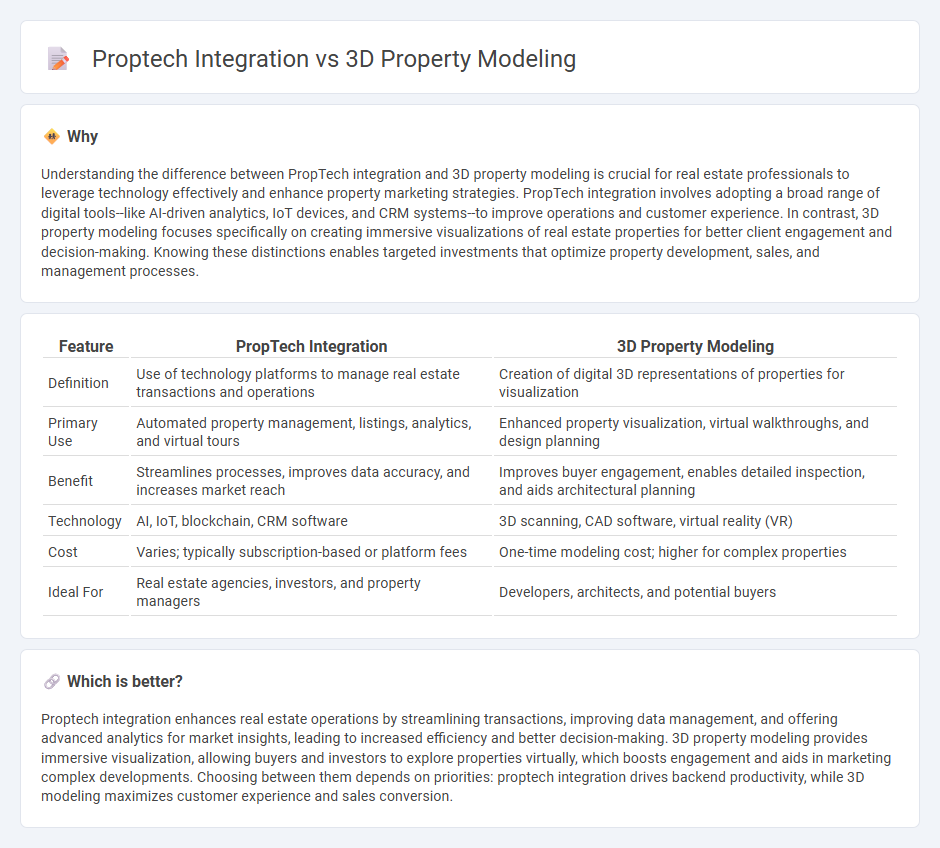
Proptech integration revolutionizes real estate by streamlining transactions and enhancing data analytics, offering seamless digital solutions for property management and investment decisions. In contrast, 3D property modeling provides immersive visualizations, allowing buyers and investors to explore properties virtually with precise spatial accuracy. Discover how these technologies transform the future of real estate by exploring their unique benefits and applications.
Why it is important
Understanding the difference between PropTech integration and 3D property modeling is crucial for real estate professionals to leverage technology effectively and enhance property marketing strategies. PropTech integration involves adopting a broad range of digital tools--like AI-driven analytics, IoT devices, and CRM systems--to improve operations and customer experience. In contrast, 3D property modeling focuses specifically on creating immersive visualizations of real estate properties for better client engagement and decision-making. Knowing these distinctions enables targeted investments that optimize property development, sales, and management processes.
Comparison Table
| Feature | PropTech Integration | 3D Property Modeling |
|---|---|---|
| Definition | Use of technology platforms to manage real estate transactions and operations | Creation of digital 3D representations of properties for visualization |
| Primary Use | Automated property management, listings, analytics, and virtual tours | Enhanced property visualization, virtual walkthroughs, and design planning |
| Benefit | Streamlines processes, improves data accuracy, and increases market reach | Improves buyer engagement, enables detailed inspection, and aids architectural planning |
| Technology | AI, IoT, blockchain, CRM software | 3D scanning, CAD software, virtual reality (VR) |
| Cost | Varies; typically subscription-based or platform fees | One-time modeling cost; higher for complex properties |
| Ideal For | Real estate agencies, investors, and property managers | Developers, architects, and potential buyers |
Which is better?
Proptech integration enhances real estate operations by streamlining transactions, improving data management, and offering advanced analytics for market insights, leading to increased efficiency and better decision-making. 3D property modeling provides immersive visualization, allowing buyers and investors to explore properties virtually, which boosts engagement and aids in marketing complex developments. Choosing between them depends on priorities: proptech integration drives backend productivity, while 3D modeling maximizes customer experience and sales conversion.
Connection
Proptech integration revolutionizes real estate by incorporating 3D property modeling to enhance visualization and streamline property management processes. Advanced 3D modeling technology allows potential buyers and tenants to virtually explore properties with precise spatial awareness, improving decision-making accuracy. This synergy between proptech and 3D modeling accelerates transactions and boosts market transparency through immersive digital experiences.
Key Terms
BIM (Building Information Modeling)
3D property modeling revolutionizes architectural design by enabling detailed spatial visualizations and accurate representations of buildings, while proptech integration enhances operational efficiency through digital tools and smart technologies. Building Information Modeling (BIM) serves as a critical bridge in combining 3D models with essential data management, facilitating improved collaboration, cost estimation, and lifecycle management. Explore how BIM-driven 3D property modeling and proptech integration transform construction and real estate industries by visiting our comprehensive guide.
Digital Twin
3D property modeling creates detailed virtual representations of real estate assets, enabling precise visualization and analysis for architects, developers, and investors. Proptech integration leverages Digital Twin technology to connect these models with real-time data, enhancing property management, predictive maintenance, and operational efficiency through IoT sensors and AI analytics. Explore how Digital Twin advancements revolutionize property management by combining 3D modeling and proptech solutions.
API (Application Programming Interface)
3D property modeling enhances real estate visualization by creating detailed digital replicas of buildings, while proptech integration streamlines operations through software solutions, with APIs playing a crucial role in enabling seamless data exchange between various platforms. APIs facilitate interoperability between 3D modeling software and proptech systems, allowing real-time updates, improved data accuracy, and enhanced user experience across property management, sales, and development processes. Explore how leveraging advanced APIs can transform property technology ecosystems and optimize your real estate workflows.
Source and External Links
Arcadium 3D House Design Tool - Arcadium is a free, user-friendly online 3D home design platform that allows quick creation of house plans with AI-assisted visualization, virtual walkthroughs, and easy sharing for designers and clients to collaborate in real time.
Planner 5D - Planner 5D offers an AI-powered 3D home design software which lets users draw floor plans and create detailed 3D models with realistic 4K renders, furnishing options, and virtual interior design experiences for homeowners and professionals.
Pix4D Real Estate 3D Modeling - Pix4D enables creation of photorealistic 3D property models from drone or handheld camera images, supporting real estate marketing with interactive virtual tours, dynamic fly-through videos, measurements, and 3D printing options.
 dowidth.com
dowidth.com